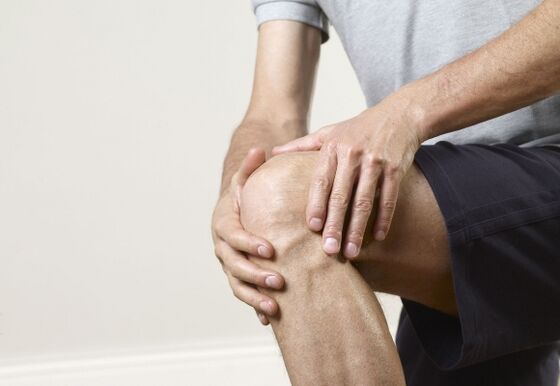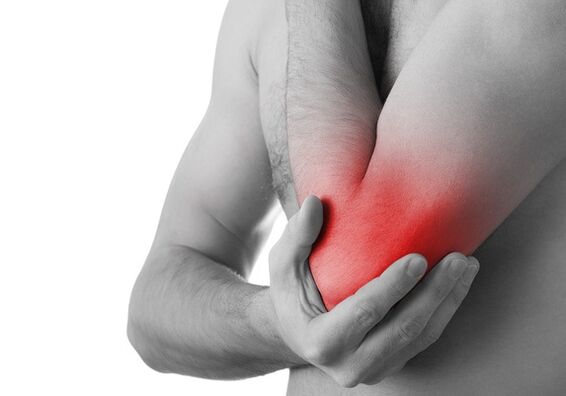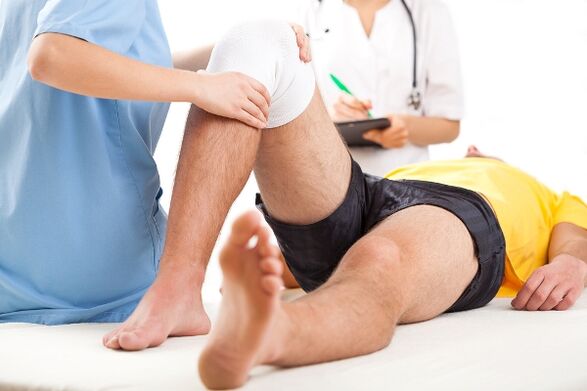Osteoarthritis is a chronic pathology aimed at damaging the joint structures of the musculoskeletal system. The main reason leading to chronic disease is metabolic imbalance, which leads to a progressive process of degenerative-dystrophic nature. The targets of the damaging reaction are the articular cartilage, connective tissue, bursae, tendons, bones and muscular corset. In the chronic form of the pathology, the periarticular muscles are involved in the inflammatory process, losing their anatomical elasticity due to deformation and swelling of the joints. To eliminate complications associated with blocking the biomotility of the skeleton and not become disabled, you need to arm yourself with information about osteoarthritis - what is it, what are the causes, symptoms and treatment.

Causes and risk factors for the development of pathology
The inflammatory-destructive process in the joints often begins for no reason. Idiopathic (primary) osteoarthritis has this onset. The mechanism of development of secondary osteoarthritis begins after certain conditions and factors, namely:
- Joint injury (fracture, meniscal injury, ligament rupture, dislocation, compression + contusion, bone fracture).
- Dysplasia (abnormal intrauterine development of joint components).
- Violation of material metabolism.
- Autoimmune-type pathologies (rheumatoid arthritis, psoriasis, autoimmune toxic goiter, systemic lupus erythematosus).
- Nonspecific destructive arthritis (with a purulent component).
- Infections of various etiologies (tuberculosis, meningitis, encephalitis, gonorrhea, syphilis, hepatitis).
- Pathologies of the endocrine glands (diabetes mellitus, toxic goiter, pathology of the adrenal glands and pituitary gland).
- Hormonal dysfunction (decreased levels of estrogens, androgens).
- Degenerative + dystrophic reactions (multiple sclerosis, Perthes disease).
- Oncological diseases.
- Blood diseases (hemophilia, anemia, leukemia).
Risk factors that cause and lead to osteoarthritis:
- Age-related changes.
- Obesity (excess body weight leads to constant vertical loads, which overload the joints, which quickly wear out, losing cartilaginous plates).
- Professional costs, that is, the load on a certain group of joints, which leads to their inflammation or premature destruction before other groups.
- Postoperative consequences: highly traumatic surgery with extirpation of affected tissues (soft, cartilaginous, bone). After restorative manipulations, the joint structure does not have the same consolidation, therefore any load leads to osteoarthritis.
- A hereditary factor, that is to say osteoarthritis, can affect one or more members of the family.
- Hormonal imbalance during menopause or after extirpation of the ovaries in women, of the prostate in men.
- Violation of water-salt balance.
- Neurodystrophic lesions of the spine are a trigger for glenohumeral, lumbosacral and hip arthritis-osteoarthritis.
- Pesticide poisoning, heavy metals.
- Temperature variations with sudden changes and hypothermia.
- Permanent trauma to a certain group of joints.
Risk factors include the environment, which has recently been saturated with high background radiation, toxic substances (smog over industrial cities and in industrial zones, as well as frequent testing of military equipment or interstate wars, which lead to ozone holes + strong ultraviolet radiation. radiation). Dirty drinking water + foods rich in preservatives lead to the development of osteoarthritis.
The mechanism of development of osteoarthritis
The triggering mechanism of osteoarthritis is based on disruption of the chain of restoration processes of cartilage cells and correction of areas of connective tissue affected by young cells. Cartilaginous plates tightly cover the end surfaces of the bones that are part of the locomotor joints. Normal cartilage has anatomically a solid structure, it is smooth, elastic and thanks to the synovial fluid, which is a biological material to lubricate the intra-articular components, it slides. It is the synovial fluid that allows unhindered movement of joint components relative to each other.
Cartilage tissue and synovial lubrication perform the main function of shock-absorbing effect, reducing abrasion of cartilage-covered bones. The bony ends are separated by pockets of fluid and a corset of ligaments and muscles firmly stabilizes them. A certain configuration and plexus of the musculo-ligamentous apparatus allows this structure to perform precise biomechanical movements such as flexion, extension, rotation + rotation. The design, thanks to the interweaving of ligaments, allows you to firmly hold in a certain position, as well as perform coordinated movements, maintaining body balance.
High stress or hormonal imbalance leads to the destruction of collagen plaques, exposing the bones. Sharp osteophytes appear in these areas; they create pain with any movement of the musculoskeletal joints. The bones thicken and false joints develop between the osteophytes, which completely changes the functionality of the organ of movement. There is less synovial fluid due to trauma to the bursa (its rupture), and the entire joint structure begins to suffer, as well as the corset ligaments + muscles. Joint swelling appears and microbial infection may also occur. Areas of ossification lead to limitation of movement and ankylosis of the joint.
Stages of clinical manifestation of joint pathology: stages
Osteoarthritis is characterized by three stages of development, consisting of:
- Step I:there are no particular morphological changes, trophism is not disturbed, synovial fluid is produced in sufficient quantity. The stability of the joint structure corresponds to average physical activity. With forced labor, pain and swelling of the joint appear.
- Step II:depletion of the cartilaginous plate is observed, foci of osteophyte islands develop and ossification appears along the edges of the joint. The pain syndrome intensifies, swelling increases and discomfort in movements appears. As the pathology progresses to the chronic stage, the pain is constant, it is accompanied by inflammation with periods of exacerbation / remission. The biomechanics are partially altered, the patient spares the joint.
- Stage III:the cartilaginous plate is completely worn away; instead of cartilage, a system of osteophytes + false fixed interosteophytic joints develops at the bone ends. The anatomical form is completely disrupted. Ligaments and joint muscles are shortened and thickened. The slightest injury can cause dislocations, fractures and cracks. The trophism of the musculoskeletal organs is damaged and they do not receive the required amount of blood and nutrients. Pinched nerves lead to an intense painful reaction, which disappears only after the administration of strong painkillers or drugs from the COX1/COX2 group.
Conventionally, one more stage can be added: the fourth - last stage with a vivid clinical picture of inflammation, infection, unbearable pain, immobilization of diseased joints, high fever and serious condition. This stage is the most serious, potentially leading to sepsis and death.
Arthrotic pain syndrome
Pain is characteristic of osteoarthritis. They intensify with movement, physical activity, with changes in weather conditions, with changes in temperature, humidity and atmospheric pressure. The pain can be triggered by any body position or sudden movements. Walking, running and prolonged upright position put a certain load on the sore joints, after which sharp or aching pain begins. In the first and second stages of pathology, the pain syndrome disappears without a trace after a night's rest, but in the advanced stage the pain is constant and does not disappear. The affected shock-absorbing layer, pinched nerves and blood vessels lead to a stagnant process with impaired trophism and accumulation of interstitial fluid. The swelling causes sharp shooting pain.

Osteoarthritis is specific for pain after a long rest accompanied by a sharp motor impulse; this condition is called initial pain. The mechanism of development of these pains is osteophytic areas covered with destructive remains of cartilaginous tissue, fibrin and viscous fluid. When the joints move, a film of these components or detritus covers the exposed areas, lubricating them and thus absorbing pain. Blockade pain occurs after products of destruction of the intra-articular space, that is, bone remains or a large film of connective tissue, enter the muscles. There is another type of pain: constant, aching, bursting + independent of movements, they are characteristic of reactive synovitis.
Attention!Blockade pain can only be treated with surgery followed by restoration of the affected joint. Treatment with folk remedies is not recommended, as it leads to the development of purulent arthrosis with the spread of infection throughout the body, and after sepsis, obvious morphological changes occur in all organs and systems.
Symptoms of joint inflammation
Symptoms are divided depending on the degree of development of the pathology. Osteoarthritis makes itself felt after 38-40 years, when the joint depreciation system begins to wear out and renewed or young cartilage pads do not appear in its place. In case of hormonal imbalance, "chaos" sets in in all vital systems, this also applies to the musculoskeletal system, therefore in the affected areas the tissues do not regenerate, but rather destruction + deformation occurs.
Osteoarthritis Symptoms:
| Degrees and periods of osteoarthritis | Description of symptoms |
|---|---|
| I graduated |
|
| IInd degree |
|
| IIIrd degree |
|
| Periods of exacerbation and remission | In osteoarthritis, exacerbations alternate with remissions. The pathology is aggravated by physical activity. Exacerbations are caused by synovitis. The pain syndrome covers all affected areas, including the muscular corset. He spasms reflexively, forming painful contractures. Osteoarthritis is characterized by muscle cramps. As the destruction increases, the pain syndrome becomes more pronounced. With reactive synovitis, the joint enlarges and takes on a spherical shape. Fluid appears in the joints, which, upon palpation, creates an effect of fluctuation. During a short remission, the pain subsides, but movement is difficult. |
Timely detection of pathology using diagnostic tests and consultation with the necessary specialists will help to pass the second and third stages, maintaining the functionality and health of all joint groups of the musculoskeletal system until old age.
Diagnostic measures
Clarification of the diagnosis is based on laboratory/instrumental studies. Each case is studied differently, that is to say with an individual approach to each patient.
The list of studies includes:
- General and biochemical blood tests.
- Blood test for rheumatoid agent.
- Urine and stool analysis.
- Radiological examination: image in three positions.
- CT scan of the joint to clarify the bone structure.
- MRI of the joint: study of ligaments and muscles.
- CT scan.
Important!Patients suffering from osteoarthritis should consult an orthopedist, rheumatologist, endocrinologist, hematologist, oncologist and patients are recommended to consult a gynecologist.
Treatment scheme
Therapeutic tactics include a whole range of measures aimed at eliminating the main cause, correcting the diet, restoring lost functions + a gentle lifestyle, that is, without special physical activity (long walk, running, carrying heavy objects). The treatment regimen includes drug treatment, local treatment, physiotherapeutic procedures and exercise therapy. Along with these methods, folk remedies are used.

Drug therapy for osteoarthritis
Complex therapy consists of:
- Drugs from the NSAID group;
- Analgesics (tablets + injections);
- Medicines that relieve muscle spasms (muscle relaxants);
- Cartilage tissue restorers (chondroprotectors);
- Antibiotics;
- Antihistamines;
- Medicines that improve blood circulation;
- Vitamins: B2, B12, PP and A;
- Antioxidants: vitamin C;
- Medicines based on hormonal substances.
It is recommended to include in the treatment regimen for rheumatoid arthritis:
- Gold medicines;
- Immunosuppressants;
- Antimalarial drugs;
- Drugs that inhibit malignant cells.
Attention!During remission of pathology, non-steroidal anti-inflammatory drugs are not recommended, they affect the gastrointestinal tract, causing numerous ulcers, and also inhibit the process of nutrition of cartilage tissue.
Ointments for local use for osteoarthritis
Local treatment has a direct effect. Gels and ointments come directly into contact with the affected tissues, quickly reaching the site, eliminating pain and inflammation. Preparations in the form of gels are widely used to restore the cartilaginous layer. Warming + anti-inflammatory ointments are used for local application.
Physiotherapy
Relief of spasmodic pain with reduction of inflammation + improvement of trophism and innervation is achieved with the help of physiotherapy. Exacerbation phases are eliminated or shortened by laser therapy, magnetic fields and ultraviolet irradiation. In the remission phase of osteoarthritis, that is, during the calm phase, electrophoresis procedures using dimethyl sulfoxide and anesthetics are useful. Destructive and inflammatory processes are affected by phonophoresis with glucocorticosteroids, inductothermy, thermal applications of ozokerite or paraffin, as well as sulfide, radon and sea baths. The muscular corset is strengthened through stimulationelectric.

Surgery
The problem of the deformed/ankylosed joint is ultimately solved by surgical interventions such as endoprostheses, as well as by a palliative method of unloading the joint framework (coxarthrosis is eliminated by transtrochanteric osteotomy + fenestration of the femoral fascia; gonarthrosis iscorrected by arthrotomy with cleaning of the intra-articular space from the remains of destruction plus artificial augmentation of the cartilage). If the bone is completely disabled, it is replaced with an artificial graft and the axis of the tibia is corrected.
Folk remedies
Traditional medicine helps to get rid of pain and inflammation, it temporarily eliminates pain and restores lost functions. There are isolated cases of complete healing through folk methods using the following tinctures, ointments and compresses:
- Garlic + onion and honey tincture: 100 g of garlic pulp + 100 g of chopped onion + 2 large spoons of honey + 200 ml of vodka. Infuses for 3 to 5 days. Apply in the form of compresses and frictions.
- Sabelnik in the form of tincture: 200 g of dry powder or fresh gruel + 200 ml of diluted medical alcohol, leave to act for 24 hours. Drink a spoonful before meals 3 times a day.
- Ointment based on badger fat and propolis: rub into joints, apply twice a day.
- Table horseradish + honey: 100 g of horseradish + 100 g of honey + 100 ml of vodka. Infuse 24 hours, drink 20 drops. This tincture can be rubbed into painful joints 3-5 times a day.
- Chilli ointment + pork fat: 1 teaspoon of powder + 200 g of fat. Infuses for 2-3 days. Used as a local warming medicine. Apply 1 to 2 per day.
- Compress: oak bark + spruce needles: 200 g of oak bark + 200 g of crushed spruce needles + 100 ml of alcohol.
It is recommended to use all listed recipes from traditional healers only after consulting a doctor. If the patient is allergic to certain medications, their use is strictly prohibited as they can lead to anaphylactic shock.
Features of prevention
Prevention is an effective tool to prevent disease, destruction and deformation of joints. For preventive purposes, you should do the following:
- Adjust the menu, from which exclude fried, fatty, peppery, salty, alcohol + nicotine.
- Add jelly and jellies to your daily menu.
- Avoid tiring loads.
- Increase safety precautions to avoid injury.
- Constantly perform a set of special exercises for the musculoskeletal system.
- Try taking vitamins B and C.
- For preventive purposes, take chondroprotectors, calcium, potassium and other mineral supplements once every six months.
- After a joint sprain or mechanical injury, get checked out by a doctor.
The list is supplemented by performing constant physical exercises to improve blood supply, innervation and restoration of the cartilaginous layer of the joints. These exercises are prescribed by a doctor.
Summary
Destruction with deformation of the joints begins after 38-40 years, so there is no need to delay the fight against this pathology. Neglected disease can lead to a wheelchair, and a rapid response to the disease with effective treatment is a clear success toward recovery. It is impossible to treat osteoarthritis yourself, this type of pathology refers to metabolic disorders directly related to changes in hormonal levels or chronic pathologies of other systems. At the first symptoms, contact a traumatologist or surgeon, do not delay, otherwise you will only be treated in a long-term rehabilitation surgical department.































